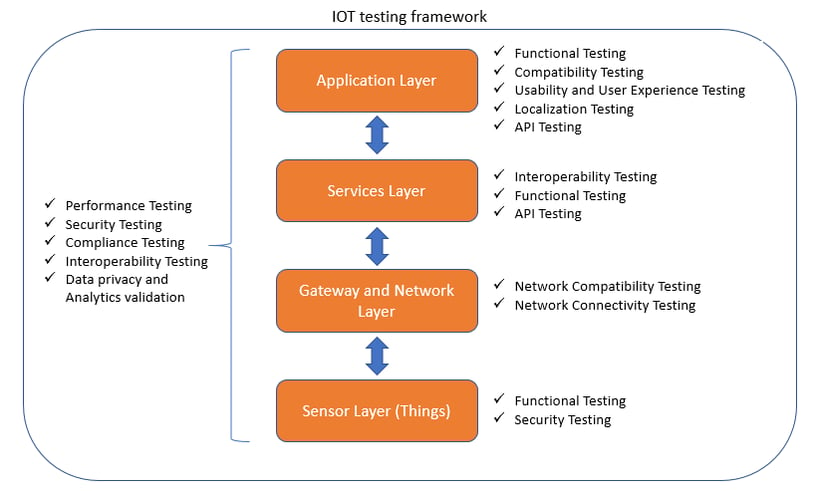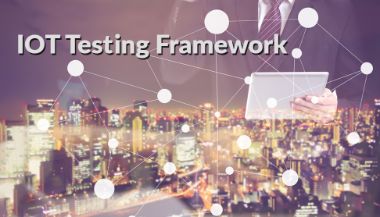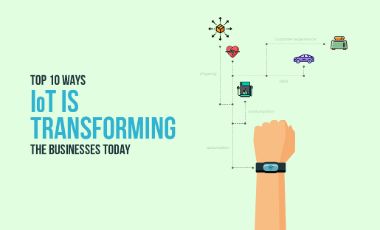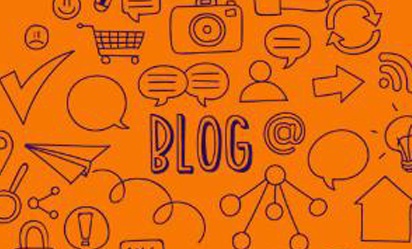The Internet of Things is on its way to become the biggest software development and testing opportunity of all time. IoT brings many new things to the table in terms of testing requirement , including quite a few unusual device types like home appliances, watch sensors etc. With such an eclectic mix of products in the IoT ecosystem, it becomes imperative for the QA team to come with an effective test strategy to meet the quality of these diverse products.
Let’s take a look at the 3 major benefits of IoT Testing -
- Improve Engagement: IoT Testing ensures that the end users get best-in-class user experience across multiple channels (device, web, mobile)
- Future-proof the business: IoT Testing provides an integrated approach to validate the practical and non-functional requirements of the IoT solutions. It also future-proofs the business by ensuring interoperability, security and performance testing
- Accelerate Time-to-Market: IoT testing ensures faster time-to-market by leveraging early automation.
Challenges in IoT Testing -
The ever-increasing number of applications that are being developed continually expands the Internet of Things (IoT) ecosystem. With such rapid expansion, organizations need to ensure that these applications are continuously and thoroughly tested before being implemented in this connected world of devices we call IoT .
Hence, the role of QA becomes critical as such a set up involves testing hardware and software and the connectivity which helps in transmitting such huge amount of intelligence.
Therefore, it becomes imperative for us to be aware of the challenges associated with IoT Testing before we can come up with an IoT Testing framework that would help us handle these challenges.
Some of the major challenges testing an IT set up are -
- Complex use cases and real-time responsiveness
- Performance requirements for high availability, rapid response, and local processing
- Security and data privacy
- Support for data volume, variety, veracity etc.
- Too many IoT protocols to test like MQTT, XMPP, CoAP etc
- Diversity in the IoT apps and devices
- Large number of sensor interactions.
Components of IoT -
As discussed above, the IoT set up introduces innumerable challenges. To overcome such eclectic mix of challenges, the QA needs to make sure a robust testing framework is in place. Though designing a framework depends on the various types of devices involved in the IOT ecosystem, some basic features that should be part of the IoT Testing framework are listed below:
- Protocol simulators: An IoT set up involves working with multiple protocols. Protocol Simulators would be very handy when there is a lot of variation in the device end points and their interfaces.
- Data Recorders: Data recorders from different types of devices can be helpful in smart validation across device sets the recorded data can be played across different device end-points automatically, which in turn can be a great enabler in compatibility testing of apps across different device sets and communication layers.
- Virtualization: The highly complex nature of the IoT ecosystem would make real-time validation of the application behavior very difficult and time-consuming. Therefore, introducing sufficient amount of virtualization into the services on which IOT applications are built will result in faster turn around and reduced costs due to minimal dependency on the real-time environment. It would also lead to earlier detection of defects.
- Building Labs that serve the entire digital portfolio to experiment and simulate real-time experiences which would help us inform smarter ways of testing.
IoT Testing Framework -
An IoT setup uses various software testing approaches from our regular QA practices to validate the IoT applications. It is important to give equal emphasis on all the three IoT core components viz Devices, Communication between the devices and computing the amount of data that needs to be processed and analyzed.

The following types of testing is recommended across the IoT ecosystem:
- Performance testing: This covers the rapidity of the communication network model, as well as the internal computation capabilities of the embedded software system.
Performance Testing in IoT needs to be done at Network and Gateway level (protocols like MQTT, CoAP, HTTP etc), System Level(Database, processing, analytics), and the Application Level.
Example: Verify response time against bench-marked time with defined connectivity conditions.
- Security Testing: This includes security aspects like data protection, device identity authentication, encryption/decryption, etc. Security Testing in an IoT framework includes both securing the devices themselves and the networks or cloud services they are connected to.
Sensor networks, real-time data collection applications, middleware, interfaces and M2M protocols are just a few variables that could bring in more injectable points and new security threats. Security test at the device and protocol level is one of the important areas where issues can be detected at the source.
Example: Verify no unauthorized access to device Or Verify the data on compromised devices can be remotely wiped out.
- Compatibility testing with the possible combination of device version, protocol version, mobile devices and mobile OS version. Compatibility testing becomes a major necessity in the Application Layer and the Network Layer of the IoT framework. It’s all about validating the possible working combination of device hardware, communication protocol versions, software versions and operating systems.
Example: Verify IoT software supports defined set of devices Or Ensure device to device communications protocols are compatible
- End-user application Testing: Includes the testing of all functional use cases of an IoT application which also includes user experience and usability testing
Example: Verify IoT application has all required features working as per the specifications Or verify whether the User Experience (UX) is good.
- Device Interoperability Testing: This involves assessing the ability to seamlessly interoperate protocols and devices across different standards and specification. In a nutshell, it verifies the connectivity across all the devices and protocols in the IoT set up. Interoperability Testing in the Service Layer of the IoT framework becomes very crucial as IoT requires standards to enable platforms that are communicable, operable, and programmable across devices, regardless of make, model, manufacturer, or industry.
Example: If a user is using an iPad as well as a Mac for IoT application, the transactions done or data saved on iPad is “As-is” when accessed through Mac desktop.
An IoT set up consists of a diverse mix of elements like Sensors, Applications, Network and Datacenter. Therefore, it becomes very important for the QA group to determine the various type of testing that needs to be conducted on these different IOT elements. Needless to say, not all types of testing are applicable for the various IoT elements.
IoT is set to play a key role in the business world as organizations increasingly look for innovative ways to maintain their competitive edge.
- Increased Productivity is the top benefit of an IoT set up.
- The Internet of Things has the potential to fundamentally change how manufacturers and services companies interact with customer, thereby improving customer experience.
- IoT opens the door for new business opportunities and helps companies benefit from new revenue streams developed by advanced business models and services
- IoT plays a big role in the Process Optimization of an organization.
- Another key benefit is the instantaneous control and response in complex autonomous systems.








